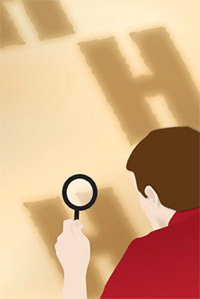

Wednesday - February 6, 2008
SLAC Today is
available online at:
http://today.slac.stanford.edu
In this issue:
symmetry: Entering Higgs Habitat
People Today: Lance Simms: Observing the Universe from Earth and from Space
Photo of the Day: Community Emergency Response Training
Stanford Lively Arts Promotes Upcoming Artists with Free Music
Conservation Tip of the Week
 |
 |
|
Wednesday - February 6, 2008 |

Image courtesy of Sandbox Studio.
symmetry: Entering Higgs HabitatThey sound like Zen koans: The Higgs field bestows mass on other particles, but its own mass is unknown. It pervades the universe, but no one has seen its physical manifestation, the Higgs particle. It's the only missing piece of the Standard Model of particles and forces, but the model accounts for just four percent of the universe. Less puzzlingly, but just as important, physicists think the Higgs field is responsible for giving mass to some particles but not others. It acts like a gooey, universe-sized bucket of molasses. As particles travel through the field, some interact with the molasses more strongly than others. Those that interact most become heaviest, while those that don't interact at all are left without mass. Without this fundamental phenomenon, the world would be a different place: heavy atoms wouldn't hold together; all elementary particles would be massless, zipping around at the speed of light; the reactions that stoke stars would go faster, slower, or not at all. |
||
|
|
||

Lance Simms: Observing the Universe from Earth and from Space
On July 20, 1969, the world heard Neil Armstrong say, "That's one small step for man; one giant leap for mankind," as he and fellow astronaut Buzz Aldrin took the first human steps on the moon. SLAC research assistant Lance Simms was not yet born at the time, but the words echoed just as clearly when he experienced this epic moment in human history at an IMAX theater as a youngster. Simms remembers that at the time, Armstrong seemed like Superman. "When I saw him get out of the lunar module and speak his famous words," Simms said, "I got goose bumps all over." The IMAX feature discussing research and adventure in outer space also showed the earth rising from behind the moon, another spectacle Simms says has stuck with him ever since. "I was completely awestruck when I saw the earth rise from the vantage point of the moon in that movie," he says, "and I remember feeling that I had to go there and see that same thing for myself." At the tender age of seven, then, Simms determined he would become an astronaut—a dream he is now one step closer to fulfilling. The Stanford graduate student in Applied Physics recently submitted an application to NASA, seeking to become part of its next class of space explorers; he is now waiting to hear if he has made the administration's cut. "Once we get to another star, or at least outside of our solar system, I think it will completely change our understanding of the universe," he says, "and I really want to become an astronaut because there is just so much we do not know and can't know until we send people out to explore." Read more... |
Photo of the Day:
|
Events
Access (see all)
Announcements
|
| | ||
|
|
||
 <%
Response.AddHeader "Last-modified", getArticleDate()
'Response.AddHeader "Last-modified","Mon, 01 Sep 1997 01:03:33 GMT"
'Monday, December 06, 2010
%>
<%
Response.AddHeader "Last-modified", getArticleDate()
'Response.AddHeader "Last-modified","Mon, 01 Sep 1997 01:03:33 GMT"
'Monday, December 06, 2010
%>View online at http://today.slac.stanford.edu/. |
||